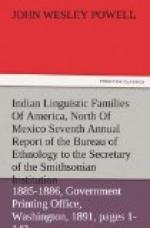The Tano of Powell (1878), as quoted, appears to be the first name formally given the family, and is therefore accepted. Recent investigations of the dialect spoken at Taos and some of the other pueblos of this group show a considerable body of words having Shoshonean affinities, and it is by no means improbable that further research will result in proving the radical relationship of these languages to the Shoshonean family. The analysis of the language has not yet, however, proceeded far enough to warrant a decided opinion.
GEOGRAPHIC DISTRIBUTION.
The tribes of this family in the United States resided exclusively upon the Rio Grande and its tributary valleys from about 33 deg. to about 36 deg.. A small body of these people joined the Tusayan in northern Arizona, as tradition avers to assist the latter against attacks by the Apache—though it seems more probable that they fled from the Rio Grande during the pueblo revolt of 1680—and remained to found the permanent pueblo of Hano, the seventh pueblo of the group. A smaller section of the family lived upon the Rio Grande in Mexico and Texas, just over the New Mexico border.
Population.—The following pueblos are included in the family, with a total population of about 3,237:
Hano (of the Tusayan group) 132 Isleta (New Mexico) 1,059 Isleta (Texas) few Jemez 428 Nambe 79 Picuris 100 Pojoaque 20 Sandia 140 San Ildefonso 148 San Juan 406 Santa Clara 225 Senecu (below El Paso) few Taos 409 Tesuque 91
TIMUQUANAN FAMILY.
= Timuquana, Smith in Hist. Magazine, II, 1, 1858 (a notice of the language with vocabulary; distinctness of the language affirmed). Brinton. Floridian Peninsula, 134, 1859 (spelled also Timuaca, Timagoa, Timuqua).
= Timucua, Gatschet in Proc. Am.
Phil. Soc., XVI, April 6, 1877 (from
Cape Canaveral to mouth of St. John’s
River). Gatschet, Creek Mig.
Legend I, 11-13, 1884. Gatschet in
Science, 413, April 29, 1887.
= Atimuca, Gatschet in Science, ibid, (proper name).
Derivation: From ati-muca, “ruler,” “master;” literally, “servants attend upon him.”
In the Historical Magazine as above cited appears a notice of the Timuquana language by Buckingham Smith, in which is affirmed its distinctness upon the evidence of language. A short vocabulary is appended, which was collated from the “Confessionario” by Padre Pareja, 1613. Brinton and Gatschet have studied the Timuquana language and have agreed as to the distinctness of the family from any other of the United States. Both the latter authorities are inclined to take the view that it has affinities with the Carib family to the southward, and it seems by no means improbable that ultimately the Timuquana language will be considered an offshoot of the Carib linguistic stock. At the present time, however, such a conclusion would not be justified by the evidence gathered and published.




